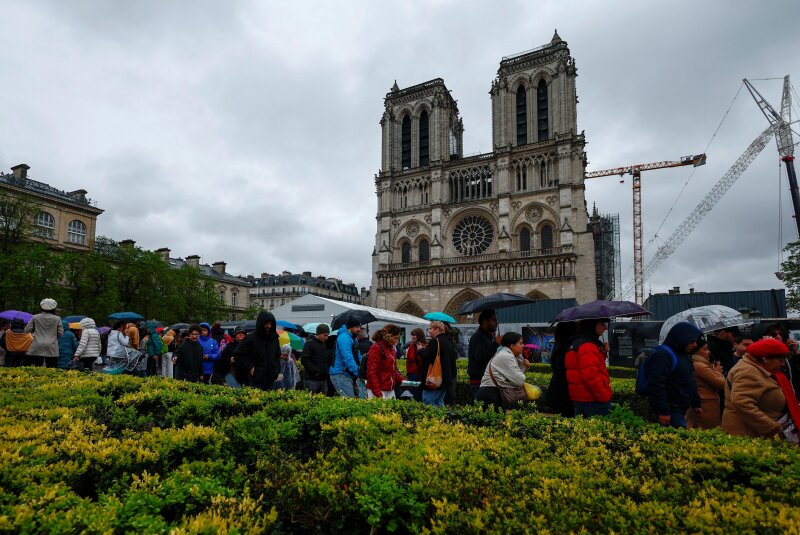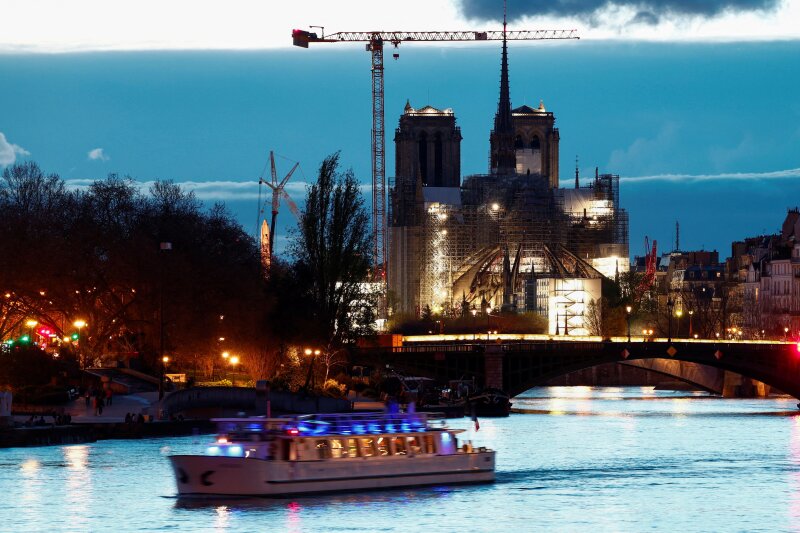
Fire 'gave us all a boost,' Notre Dame chaplain says as Paris prepares for cathedral's reopening
By Caroline de Sury, OSV News
04/09/2024
PARIS (OSV News) — For some, the Notre Dame fire was a sign of devastation of faith and Christian values. But for many more in France, it meant awakening of faith on an unprecedented scale.
"The fire gave us all a boost," Father Henry de Villefranche told OSV News, speaking of a "renewed vitality" encouraged by the Notre Dame worksite. "The church was asleep. Some people were behaving badly. In that respect, the fire was providential. It pushed us all to move forward and give our best."
Few know it better than the chaplains of the iconic cathedral and Father de Villefranche is one of them, but the only one remaining from before the fire. A few yards from Notre Dame, in an old medieval street, on Ile de la Cité, he works on ensuring continuity of Notre Dame's heritage with the new team, responsible for the liturgical life of the renovated cathedral.

2024, as restoration works continues. The cathedral, heavily
damaged by a fire April 15, 2019, will reopen to the public
and to worship Dec. 8.
OSV News photo/Gonzalo Fuentes, Reuters
Ile de la Cité is a famous island on the Seine River, one of two natural islands in Paris and the heart of the French capital. It's where Notre Dame Cathedral is located and where hundreds of shocked Parisians watched as flames consumed the cathedral's medieval roof April 15, 2019, praying that Notre Dame would be saved as the spire collapsed around 8 p.m.
The fire, which had broken out around 6.50 p.m. in the timbers of the roof, was overcome by about 3.30 a.m., according to the Paris fire department. Two-thirds of the roof was destroyed. It was Monday, the first day of Holy Week.
Noémie Teyssier d'Orfeuil, a young teacher, was there and since then, she has coordinated the "pilgrimage of living stones" through the streets of Paris every year on Holy Monday.
"The idea is that we are all the 'living stones' of the church," she told OSV News. "Every stone is important, and the church is incomplete if one is missing." The youth teams who work with Teyssier d'Orfeuil are striving to bring together Catholics from a wide variety of Paris parishes, those affluent and busy and those poorer and more isolated. The diocesan solidarity unit helps them involve members of Catholic charities, so that street people and disadvantaged populations have a privileged place during the event, as well as people with disabilities.
Teyssier d'Orfeuil also is working with hundreds of young volunteers to organize seven major pilgrimage routes to Notre Dame, across France, from July 28 to Sept. 14, in preparation for the Dec. 8 reopening.
The cathedral welcomed between 12 million and 14 million visitors every year before the fire. The influx is expected to increase after the reopening. With this in mind, Father de Villefranche and his team are setting up a didactic trail, designed to enable visitors to explore the essentials of Christian history and faith as they stroll around the cathedral. It's for those searching for their faith and for those wanting to deepen it.

Cathedral March 31, 2024, as restoration works continues.
The cathedral, heavily damaged by a fire April 15, 2019, will
reopen to the public and to worship Dec. 8.
OSV News photo/Gonzalo Fuentes, Reuters
"Notre Dame is a holy place, just like Jerusalem," Father de Villefranche pointed out. He speaks Hebrew and knows the Holy Land like the back of his hand. "Notre Dame, too, is a place that leaves no one indifferent, a place where God can be encountered," he told OSV News.
The chaplains of Notre Dame designed a new itinerary and renamed the side chapels. The visitors' route will begin on the left as they enter. The aisle running along the left-hand side will be named the "Alley of Promise," and will take visitors through seven chapels dedicated to the great witnesses of the Old Testament.
"Until now, those chapels were black with grime," Father de Villefranche explained. Now they are cleaned up and are "superb," he said, "but they need to be outfitted. There is nothing inside, and their white stained-glass windows tell no story."
Visitors then will continue to the choir, and see the 14th-century statue of the Virgin and Child, evoking the incarnation of Christ, and the new reliquary for the crown of thorns, a reminder of the redemption.
They will then walk to the other side of the nave through the "Pentecost Alley," which chapels will be dedicated to the church after Christ's resurrection, including evocation of the gifts of the Holy Spirit and the saints.
"Furnishing these newly named chapels will take about 10 years," Father de Villefranche said. "The looting and ransacking of the French Revolution in 1789 and the July Revolution in 1830 left us with few objects at our disposal. We will have to order new statues, tapestries and stained-glass windows, particularly to represent Pentecost."
The chaplains also are working on new rituals for liturgical moments specific to Paris cathedral. The morning daily Mass logistics will be improved. "In the past, people entered through one of the side doors," Father de Villefranche said. "From now on, they will enter through the large old central portal of the Last Judgment. The priest will be waiting for them at the entrance, as the door opens. They will pass through the baptistery and pray the Angelus, before proceeding to the altar for Mass."
In Notre Dame, Masses and other services are celebrated while tourists continue to stroll around. "It is much better for the visitors," Father de Villefranche pointed out. "A church is interesting when there is something going on! Many are touched. This visit does not leave anyone unmoved."
For Father de Villefranche, "culture and worship should not be separated, but rather linked. Worship is expressed in a culture, and culture enables us to understand the signs of worship. We hope that visitors who enter as tourists leave as pilgrims," he explained.
With this in mind, the CASA Notre Dame guides association, for which Father de Villefranche is chaplain, trains teams of volunteer guides throughout the year to explain to tourists the elements of the Christian faith needed to understand the iconic cathedral.
Jean-Baptiste Bertrand recruits young people, often foreigners, for summer tours. Housed in Paris and trained on site as soon as they arrive, they guide the visitors for two weeks, while living a fraternal community life, structured by prayer.
This summer they will still be only offering tours of the cathedral's exterior. "But it's already a fascinating visit," Bertrand said. "There's so much to say about the cathedral's exterior. And in the summer of 2025, they'll be able to go inside," he said, referring to when the cathedral will be reopened to tourists and pilgrims.
Father de Villefranche told OSV News that personally, he is "not very interested in the official ceremonies to reopen the cathedral, with the president of the republic and all the officials," adding with a smile that for his part, he is "signing up to celebrate the first ordinary Mass of the week that follows. That is when everything will really begin."
-
